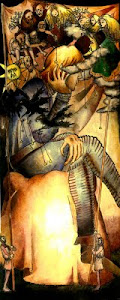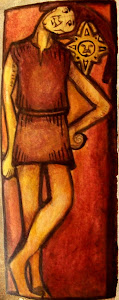
Last year my history 1 professor introduced to us through a documentary film an unusual and interesting tribal story in the rough and remote mountains of Capiz in the Philippines. There is a community there, just like any isolated group of people, with their last binukots, a seventy three year old grandmother named Isiang. Binukots are the princesses chosen by their community as the most beautiful woman in the place. She will stay in a hut, unexposed to sun and any kind of labor. Whenever she gets out, she must cover with a cloth for protection from the outside elements, and she is lying on a hammock attatched to a bamboo pole carried by men or her servants. She never exposed to public, and her husband was chosen by her parents.
She wear a veil so that nobody could see her face, perhaps except to her closest servants. She had the best food in their community. The binukot is also bathed by her servants, and she never allowed to work, even going to school. All she have to do is to memorize by heart their priceless heritage, the hours-long epic song. The ten epic songs is about the history of their tribe and the lineage of the family of binukots, mixed with exaggerated stories and tales that are considered legendary. These epics are the "Tikum Kadlum," "Amburukay," "Balanakon," "Sinagnayan," "Kalampay,"and "Nagbuhis," "Pahagunoy" and "Alayaw".The song is passed only to the binukot, and her successor should also memorize the epic song, and so on.
Since binukots never allowed to do any work, they become frail and weak. During the second world war, where the Japanese occupied the country, their were the first victims since they can't run or probably even walk. Quite sadly, the binukots seemed raped. So after that the family of producing binukots stopped, until it gradually fades. They say that only seven binukots left, and they are all too old now.
The famous binukot, Elena Gardoce died recently at the age of 98. Her daughter and apparent successor Angga, forced to become a binukot to preserve their tradition and the generations-old songs. But Elena's grand daughter Emily refused to take her mother's place. Rather she wanted to become a teacher. It is quite sad to see them gradually fade, especially the remaining seven binukots who know the song by heart.

Picture of the binukot courtesy of flickr.com
And also, thank you, thank you so much for your concern about the typhoon Ondoy. Well, luckily, we live in a nearby hills so the flood didn't reached us, only the heavy rain and wind, and also brownouts. Maybe I should also say sorry because you worried too much about what happen to me (especially the bunny, sorry if I worried you.). Again thank you for your concern.































